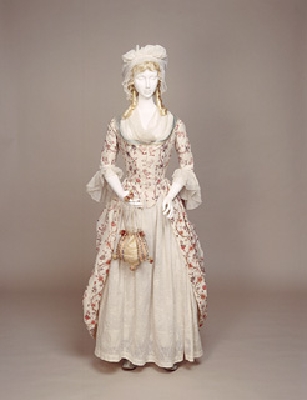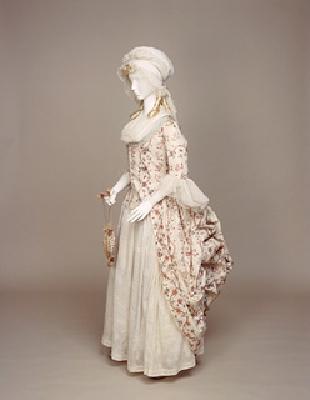polonaise dress
Summary
Open robe of cream glazed Indian chintz, painted in India with rows of stylised sprigs then block printed with alternating bands of floral wavy lines in England. There is also some overpainting in colour. Bodice is closed with a pointed waistline and elbow-length sleeves. The skirt is cut in 3 widths, closely pleated onto the bodice, with a slit below the waist on each side. 5 tape ties inside skirt, threaded with blue silk cord with tassel at each end for looping skirt up " à la polonaise". A double layer of muslin ruffles is gathered onto the band and sewn onto the sleeve.
Display Label
There seems to be less dramatic change in the style of the wardrobe of the fashionable woman in the eighteenth century, than in the nineteenth, certainly in the essential types of dress. All dresses fitted a pattern, being ankle or floor length, with elbow length sleeves and a squared neckline, sometime with a short train, and with the skirt worn either closed, or open to show a decorative skirt or "petticoat". Around 1700, a gown known as a mantua was popular for most social occasions, comprising a long straight silhouette incorporating a short train, orginally worn down, and later looped up. By the middle of the century, two newer styles had taken over, the informal English robe or "nightgown" with the back tightly gathered into the waist, and the more formal French or "sack back" gown with flowing pleats from the shoulders. Other variations included the polonaise (with the skirt looped up over the petticoat as in an image below), and more simple "round gowns", which were increasingly popular as neoclassical influences developed after the 1780s (see Heideloff fashion prints below). Fabrics chosen were usually woven silk brocades or damasks, often in a stylised floral design until the 1770s, with simpler printed cotton callico and linen, or embroidered cotton muslin, increasingly fashionable thereafter.
Object Name
polonaise dress
Date Created
1775-1780
Dimensions
Length: 155cm
Hem: 248cm
Waist: 70cm
accession number
1947.1606
Collection Group
Place of creation
United Kingdom
Medium
Legal
© Manchester Art Gallery



